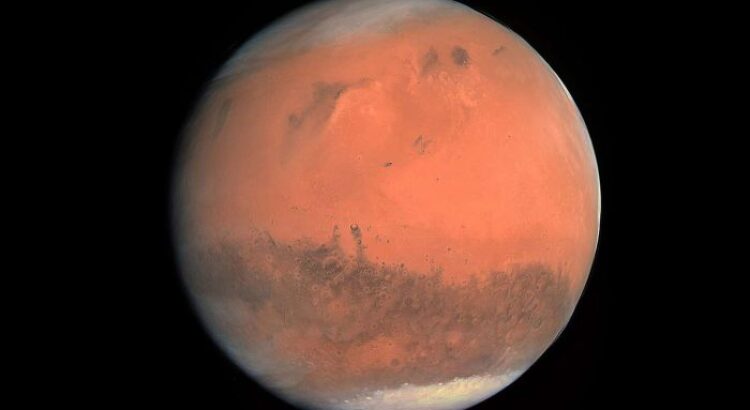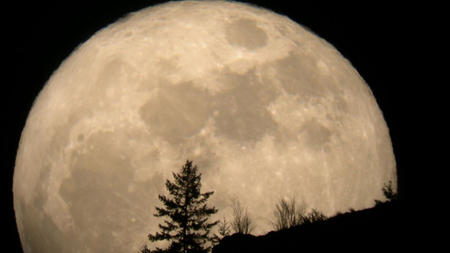A maxi-Mars, a mini-moon and meteors light up the October
night sky
Get set to be dazzled by the big beautiful glow of mysterious Mars this weekend as it puts on a show with the Moon.
The Red Planet is getting bigger and brighter every day as it makes its closest approach to Earth since July 2018.
On Friday evening (October 2) Mars will appear close to the full moon above the north-eastern horizon at 8:00pm.
But this is no ordinary full Moon.
It’s a mini-Moon — a full Moon that occurs at the most distant point in its orbit from Earth each month — so it will appear slightly smaller than usual.
And it’s actually the first of two consecutive minimoons, which means the Mars-and-Moon show will look even more spectacular on Saturday night.
«It will be best on 3 October when Mars and the Moon are only about a handspan apart,» says amateur astronomer Ian Musgrave.
The Red Planet will be at its biggest next week
Mars will be at it’s closest point to Earth on October 6 at 14.10 UTC.
Depending upon which Australian time zone you live in, that will either be late Tuesday night (WA and NT) or early Wednesday morning on October 7.
But don’t let anyone tell you it will be bigger than the Moon — even a mini-Moon.
This internet hoax does the rounds every time Mars reaches its closest point (known by the astronomical term ‘perigee’), but from where we stand Mars is more than 60 times smaller than the Moon.
Mars and Earth come close to each other around every two years — that’s because Mars takes 26 months to orbit the Sun, compared to Earth’s 12 — but the distance between them varies each time.
This time it will be 62.07 million kilometres away from Earth.

Mars continues to get brighter and brighter until Wednesday October 14 when it reaches ‘opposition’, in other words it is in a direct line with Earth and the Sun.
The reason why there is a week’s difference between the closest approach and opposition comes down to the elliptical shape of the Red Planet’s orbit, explains Jonti Horner, an astronomer at the University of Southern Queensland.
«If the orbits were perfectly circular then the closest approach and opposition would occur at the same time,» Professor Horner says.
The closest approach happens when opposition coincides with ‘perihelion’ — the point where Mars is closest to the Sun. This happens about every 16 years.
In 2018 Mars and Earth were separated by 57.6 million kilometres, but in 2003 they were only 55.7 million km apart — the closest they’d been in 60,000 years.
Although not quite as close as those, this opposition will be the best until 2033.
After October 14, Mars will start to become dimmer, but will still be one of the brightest objects in the sky until the end of the month, Dr Musgrave adds.
«By the end of month it will be still be brighter than Jupiter,» he says.
Venus, Leo and the Moon
Mars is not the only planet to shine in the first half of the month.
Venus will be spectacularly close to Regulus, the brightest star in the constellation of Leo, in the eastern sky on the morning of October 3 between 5:00am and 5:30am.
«They’re going to be less than half a finger apart,» Dr Musgrave said.
Then, on October 14, Venus and Regulus will form a pretty triangle with the crescent moon in the early morning sky.
Meteor showers
The annual Orionids meteor shower lights up the early morning sky between October 21 – 23.
This meteor shower is caused by Earth passing through the dust stream of Halley’s comet, the same comet that is responsible for the Eta Aquarids shower earlier in the year.
It’s not as spectacular as the Eta Aquarids, but you could see at least 13 meteors an hour between 4:00AM and 5:00 AM at the peak of the shower if you are in a dark area.
Not only will the meteors start high in the sky an hour before sunrise, the first quarter Moon will be below the horizon.
«The best time to see it is the morning of the 22nd, but you’ll see decent meteor rates on the 21st and 23rd, Dr Musgrave says.

To find the Orionids, scan the northern sky and look for the ‘Saucepan’. This is actually the belt of the constellation of Orion.
The meteors will come out from a point below the belt near a big orange star called Betelgeuse and shoot up through the belt.
«If you can see the stars of the belt then you’ve got a good chance of seeing a meteor,» Dr Musgrave says.
If you are very lucky, you may even see a meteor shooting in from the left from the neighbouring constellation of Taurus.
The southern Taurid meteor shower (formed out of debris from Comet Encke) peaks on October 10 but runs right through the month.
However, the rates are much lower — only two meteors an hour at the peak.
Even though the rates are very low, Taurid meteors tend to be brighter than Orionid meteors, says Professor Horner.
«If it’s moving quickly its an Orionid meteor, if it’s moving slowly it’s a Taurid,» he says.
Fuente de la Información: https://www.abc.net.au/news/science/2020-10-02/mars-mini-moon-and-meteors-light-up-october-night-sky/12637676?nw=0









 Users Today : 29
Users Today : 29 Total Users : 35460412
Total Users : 35460412 Views Today : 54
Views Today : 54 Total views : 3419217
Total views : 3419217